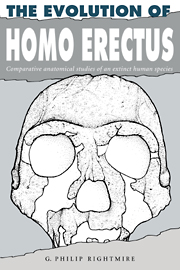Book contents
- Frontmatter
- Contents
- Preface
- 1 Introduction
- 2 Homo erectus in the Far East
- 3 Homo erectus at Olduvai Gorge
- 4 Discoveries from the Turkana basin and other localities in sub-Saharan Africa
- 5 Northwest Africa
- 6 Comparisons of African hominids with Asian Homo erectus
- 7 Homo erectus as a paleospecies
- 8 The transition to more modern forms
- 9 Summary and prospects for further research
- References
- Author index
- Subject index
8 - The transition to more modern forms
Published online by Cambridge University Press: 14 October 2009
- Frontmatter
- Contents
- Preface
- 1 Introduction
- 2 Homo erectus in the Far East
- 3 Homo erectus at Olduvai Gorge
- 4 Discoveries from the Turkana basin and other localities in sub-Saharan Africa
- 5 Northwest Africa
- 6 Comparisons of African hominids with Asian Homo erectus
- 7 Homo erectus as a paleospecies
- 8 The transition to more modern forms
- 9 Summary and prospects for further research
- References
- Author index
- Subject index
Summary
Early in the Middle Pleistocene, Homo erectus can be documented from fossils found in the south, eastern and northwestern parts of Africa, in the Far Eastern tropics, and in the cooler reaches of northern China. Populations inhabiting these far-flung regions of the Old World are anatomically similar, and the morphology of the species seems to have changed little over more than a million years. Differences in behavior are apparent from careful study of the prehistoric record, however. In Africa, Middle Pleistocene humans utilized an Acheulian technology, while at sites such as Zhoukoudian in China, the chopping tools associated with Homo erectus do not include handaxes. The extent to which these changes reflect divergent practices of procuring food or processing other materials is still not clear. In Java, few stone tools of any sort are found in the deposits yielding ancient hominids. It has been argued that these people of the south-east Asian forests used bamboo or other woods, rather than stone, to manufacture implements. These lines of evidence suggest that groups of Homo erectus were adapting differently to local circumstances. Some bands presumably coped more efficiently than others, although the pace of technological and cultural advance seems to have been slow in most regions. Over the course of millenia, many local populations probably decreased in size or died out altogether.
A plausible scenario is that such extinctions became more common later in the Middle Pleistocene, as a new form of Homo evolved and spread across the landscape.
- Type
- Chapter
- Information
- The Evolution of Homo ErectusComparative Anatomical Studies of an Extinct Human Species, pp. 204 - 233Publisher: Cambridge University PressPrint publication year: 1990

